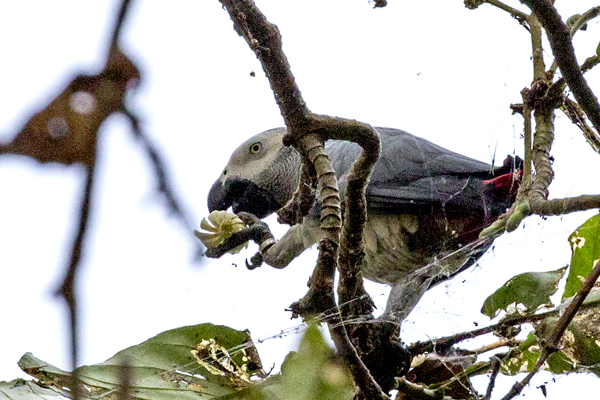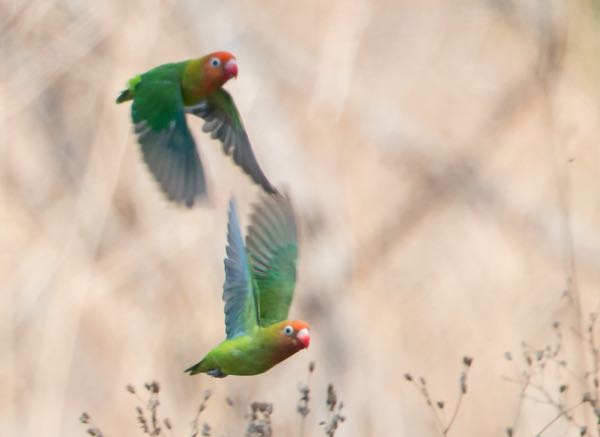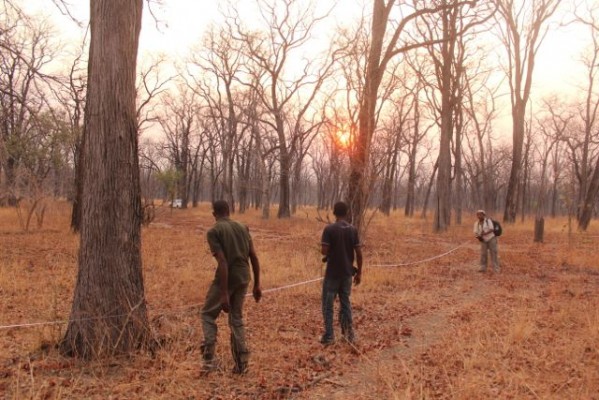Over three years ago, 17 Grey parrots were released on Ngamba Island, in Lake Victoria, Uganda. These parrots were the sole survivors of an original group of 108 wild Grey parrots that were likely trapped in the Democratic Republic of the Congo, and later confiscated by authorities as they were being smuggled into Bulgaria.

The pre-release aviary holding 17 Grey parrots. Photo by Dr. Rowan Martin.
The 108 birds were housed temporarily in the Sophia Zoo in Bulgaria, while the World Parrot Trust sought a suitable release site for the birds, and secured the various bureaucratic permissions required for release.
Following quarantine, rehabilitation, and health checks, the 17 surviving birds were released from the Ngamba Island Wildlife Sanctuary by Dr. Jane Goodall. It was unclear at the time whether these birds, which had been living for over 3 years in a zoo, would retain the repertoire of behaviors needed to survive in the wild.

Dr. Jane Goodall doing the honor of releasing the birds. Photo by Charles Bergman.
Post-release monitoring of the birds showed declining visits to the sanctuary feeders over time. Had the released birds died, or had they become true wild birds?
This summer, we gained some insight. Sherry McElvie, a resident on nearby Bulago Island, and a wildlife enthusiast who was present at the release, recently spotted a group a grey parrots feeding on trees in her garden. Closer examination of photos taken confirmed that at least one of them had a ring identifying it as one of the 17 birds released on Ngamba Island (9 km distant), 3 years before.

A ringed Grey parrot, re-sighted 3 years later. Photo courtesy Sherry McKelvie.
This is great news, as it suggests that parrots confiscated from trade can adapt to a life in the wild, despite having spent extended periods in captivity.
This ground-breaking project was the result of hard work by numerous individuals and organisations committed to returning these parrots to the wild. In Uganda the CSWCT (Chimpanzee Sanctuary and Wildlife Conservation Trust), UWEC (Uganda Wildlife Education Centre), JGI Uganda (Jane Goodall Institute Uganda) and UWA (Uganda Wildlife Authority). In Bulgaria the vision of the Bulgarian Biodiversity Foundation and Bulgarian Ministry of Environment and Water were instrumental to the success of the project.
This week Dr Tiwonge Gawa sets off on a two month expedition as part of a World Parrot Trust project aimed at understanding the conservation needs of Lilian’s lovebirds. Dr. Gawa, who recently won an award as a leading International Young Conservationist is heading up a team of researchers to explore little-travelled areas of the Zambezi basin. The team, which includes researchers from the University of Edinburgh, BirdWatch Zambia and The Percy FitzPatrick Institute of African Ornithology, want to understand the current distribution of Lilian’s lovebirds and their habitat requirements. Lilian’s lovebirds are generally considered specialists of Mopane woodlands where they roost in mature trees but this habitat is under threat in southern Africa. A key aim of the expedition is to understand the strength of the lovebird’s association with Mopane woodlands, and importantly to understand the drivers of changes to woodlands within the lovebird’s range.



